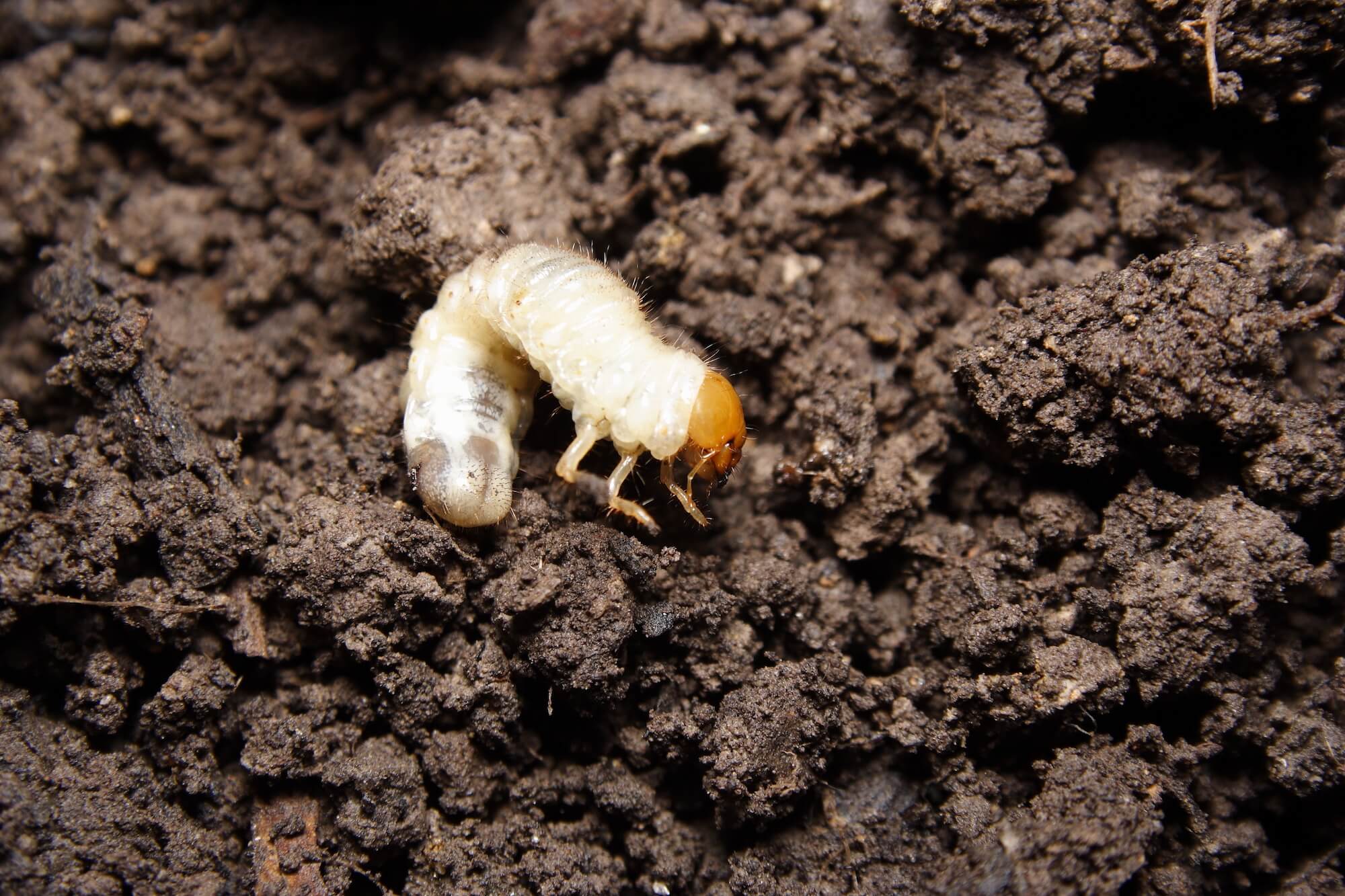How to Get Rid of Lawn Grubs
Have you noticed that your lawn seems to look dry and brown—even when you’re following a regular watering and fertilizing schedule? The culprit could be an infestation of lawn grubs. Lawn grubs are common property pests that feed on the roots of your grass, causing damage and draining your soil of the nutrients it needs to keep your lawn looking healthy and green.
If you think you have a grub problem in your lawn, it’s important that you take action as quickly as possible to maintain the health of your property. Our guide to tackling this stubborn pest will help you restore the gorgeous green lawn you want.

What are Lawn Grubs?
Lawn grubs (sometimes referred to as “white grubs”) are the immature form of a variety of Scarab Beetles. From Japanese Beetles to June bugs, most of the country’s most commonly seen beetles start out as grubs.
You can identify a lawn grub by looking for its distinct shape. Lawn grubs are white in color and have soft, C-shaped bodies. Grubs have legs near their heads and can typically be found just a few inches below the crust of your soil. Grubs are most active in spring, when they awaken from winter hibernation and begin feeding on your grass’s roots. Throughout the summer, grubs will mature and develop into beetles, which will then dig their way out of your soil to mate and lay eggs in your lawn. In the fall, the grub eggs hatch, the new grubs begin feeding on your grass’s roots, and the destructive cycle begins to take its toll on your lawn once again.
Though many lawns have a small percentage of grubs, an infestation of these pests can do serious damage to your lawn. Grubs’ primary source of food as larvae is roots because beetles lay their eggs a few inches in the soil. When grubs hatch, they immediately begin destroying the roots of your grass, which can cause dead, brown patches to emerge. Grubs can also invite animals and other types of pests into your lawn in search of food. This makes it especially important to act as soon as you believe that you might have grubs in your lawn.
How Can I Tell If I Have Lawn Grubs?
Spotting the signs of lawn grubs doesn’t need to be difficult. Here are a few of the most common signs that you might have a few too many grubs in your lawn.
- Sections of damaged grass: Grubs feed on the roots of your grass, which means that a grub infestation makes it very difficult for your grass to get the nutrients and water it needs from the soil. One of the first signs of a grub infestation you’ll usually notice is dying patches of grass in your lawn. If you have circles of yellow or brown grass that seems resistant to other types of treatments, grubs could be behind them.
- Spongy grass: Your grass’s roots anchor it into the soil. After grubs begin feeding on your lawn, your grass will become weaker and more susceptible to disease. If you can pull your grass up easily by the roots, it may be because grubs have been snacking on your lawn. In some cases, your turf might even roll up like carpet if it has been severely damaged.
- Susceptibility to other diseases: Grubs don’t only cause damage by eating your grassroots — they also destroy the overall health of your lawn. Lawns that have been damaged by grubs don’t have the resources and nutrients they need to fight back against fungal infections, disease, drought and other types of environmental stress. If you’ve noticed that your lawn seems to be particularly quick to see health issues, you could be dealing with a grub problem.
- Uninvited guests on your property: Animals like raccoons, moles, skunks, and birds feed on grubs throughout the year. If your lawn has a higher concentration of grubs, you might notice these animals hanging around your property or digging up your lawn more often than your neighbors.
If you notice one of the tell-tale signs of grubs in your lawn, it’s best to perform a soil test to confirm that you have grubs before beginning treatment. First, survey suspicious parts of your lawn. Late August and early September are the best time to search for grubs because this is the time when grubs tend to head towards the surface of your soil. Use a spade to dig up one square foot of sod in a few different spots in your lawn. You’ll want to dig about two to four inches into the soil in each area.
After pulling back the section of sod, look for grubs. Some grubs are okay and won’t cause major damage to your lawn. Count the number of grubs and determine how to proceed based on the following recommended guidelines.
- Less than five grubs: A few grubs in your lawn isn’t a problem. If you have five or fewer grubs in each section of sod, no treatment is necessary.
- Five to nine grubs: This level of infestation might cause visible damage to your lawn. If your lawn looks unhealthy or you have animals digging up your lawn, you might want to seek treatment.
- Ten grubs or more: This level of infestation is very likely to cause visible damage to your property. You’ll want to create a plan for treatment as soon as possible. In extreme cases, you may also want to call for professional grub control services.
If you do notice that you have grubs in your lawn, don’t panic. You have a wealth of both organic and chemical treatment options that can help correct your lawn and get your grass back on track to healthy growth.
Organic Methods for Removing Lawn Grubs
If you’re the type of homeowner who prefers natural lawn care solutions, you may want to consider the following three organic treatments for grub infestations.
Beneficial nematodes
Beneficial nematodes are microscopic roundworms present throughout most types of soil. Nematodes feed on larvae like white grubs by entering the grub and injecting a toxic form of bacteria. This bacterium kills the host within 24 to 48 hours and transforms the body into a source of food for the nematode. Though nematodes pose no danger to humans, they can be an effective and natural way to kill off white grubs in your lawn. Though beneficial nematodes can be a powerful treatment for removing grubs from your lawn, this method may take up to three years to fully remove your infestation.
You can purchase beneficial nematodes from your local gardening center or online source for gardening supplies. Five million nematodes will treat about 1,600 square feet of property, so be sure to measure your lawn before you invest. It’s best to apply nematodes to your lawn in two periods spread seven to ten days apart—this ensures that the nematode population can completely cover the life cycle of the grubs on your lawn. Be sure to apply your nematodes as soon as you get them, as they’re living creatures that can easily die off if they aren’t able to feed.
Milky spore
Milky spore is a unique type of bacteria that is effective at killing off Japanese Beetle larvae. This treatment is completely harmless to humans and other types of animals but is still one of the best treatments for handling Japanese beetle infestations. When the larvae make contact with the milky spore, their bodily fluids turn milky, which kills the larvae. Like beneficial nematodes, this method of grub removal may take up to three years to become fully effective.
When applying milky spore, timing is important. The ideal soil temperature for applying milky spore is between 60- and 70-degrees Fahrenheit, which means that early fall is the best time to treat your lawn. You can also use this treatment in your vegetable garden without fear of harming your plants or local wildlife.
Chemical Methods for Removing Lawn Grubs
If you need a faster and more thorough treatment to correct grub infestations in your lawn, you may want to consider a chemical treatment. The best type of chemical treatment for your lawn will depend on the season and the severity of your infestation.
Curative treatments
Curative treatments will kill off current grub populations. If you already have grubs in your lawn and they’re causing noticeable damage, you’ll want to seek a curative treatment for your lawn. Here are the steps you’ll go through to apply curative treatments to your lawn.
- Check your thatch layer: Curative grub treatments are sold in the form of liquid or granules, which mean that they might need a bit of assistance seeping into your soil. Be sure that your lawn’s thatch layer is around half an inch or shorter for the best possible treatment.
- Water your lawn: Before you apply your treatment, be sure that you water your soil. This allows the treatment to fully soak into your soil.
- Apply the treatment as directed: Different types of curative treatments are made up of different chemicals that target grubs at specific stages in their lifecycle. This means that the best time to apply your treatment will vary depending on the treatment you choose.
- Apply a second treatment if needed: Depending on the treatment you use and the life stage that your treatment targets, you might need to apply a second layer of chemicals to kill off grubs that were not near the surface during your first treatment.
Preventive treatments
If you don’t currently have grubs in your yard, you may want to apply a preventive treatment to keep your lawn healthy. Preventive treatments kill off white grubs before they reach the larvae stage and must be applied before your lawn has already been damaged in order to be effective.
Most preventive grub treatments include the compound chlorantraniliprole and should be applied in April or May. This leaves enough time for the treatment to penetrate deep enough into the soil to kill off emerging white grubs before they’re able to damage your property.
Preventing Grubs the Natural Way
If grubs are a common occurrence where you live, you will want to take steps throughout the year to prevent an infestation before it can reach your property. Here are a few effective organic methods you can use to prevent grubs from making their home in your lawn.
- Maintain healthy grass: Beetles don’t like laying eggs in healthy lawns because thick grass is more difficult to burrow through. Maintaining an effective lawn care schedule on your own or in conjunction with a team of local professionals can help you keep your lawn grub-free.
- Mow high: Beetles tend to avoid lawns with longer grass when choosing a place to lay their eggs. If your area is prone to grubs, you may want to keep your grass a bit longer—especially in the spring season.
- Don’t overwater your lawn: Overwatering your lawn can cause your soil to become soft, which makes burrowing and egg laying easier. Avoid overwatering your lawn and be sure to overseed dead patches to make your property inhospitable to grubs and beetles.
Bringing in the Professionals
Sometimes, the best way to deal with a stubborn grub problem is to call in the professionals—and there’s no better local team than TruGreen. TruGreen is an expert lawn care service provider offering all of the grub and lawn treatments that you need to keep your property looking great. Give our team a call today at 877-349-9084 learn more or schedule your Healthy Lawn Analysis.







